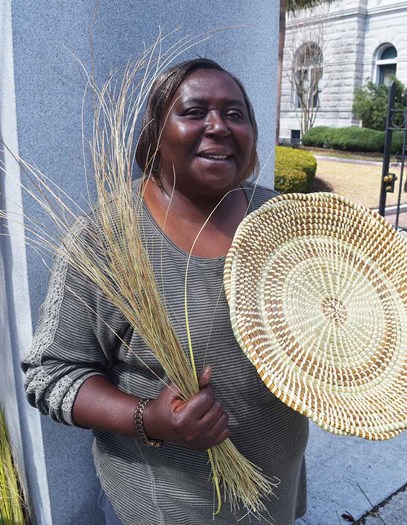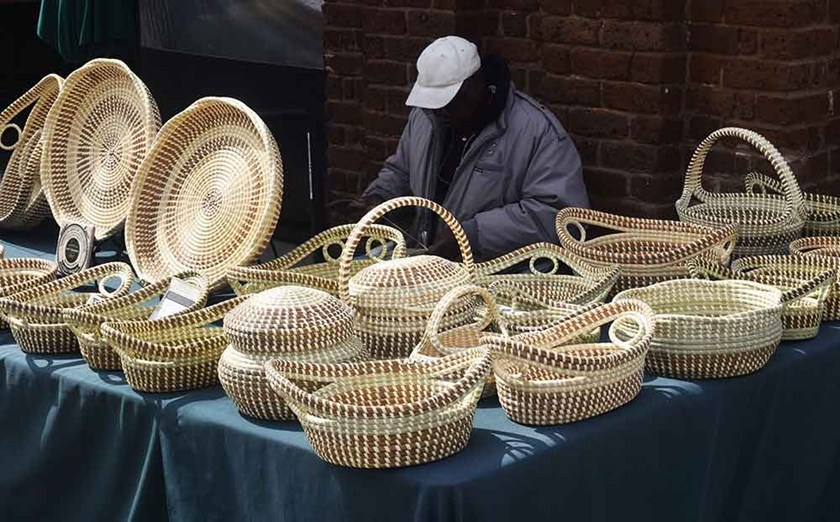CHARLESTON, SC - Laurie Bonneau’s lovely moon-shaped face beams with pride as she shows the stranger a sweetgrass basket her 13-year-old son has made.
“Our children start making the baskets when they are very young; my kids can make one of these sweetgrass roses (used as bookmarks) in a matter of seconds,” boasts the engaging Laurie, whose stand at the corner of Broad and Meeting streets in Charleston’s Historic District is laden with lots of the intricate hand-woven baskets that have become prized souvenirs for the millions of tourists who visit this charming city each year.
“It takes me about 12 hours to make one of these,” says Bonneau while holding up one of the larger coil items she identifies as a “rice fanning basket,” which was used to “air and clean rice in the old days. Now people use them as fruit and bread baskets.”
Bonneau and the other sweetgrass basket makers who lovingly ply their craft on Charleston’s street corners are continuing a tradition that dates back to America’s darkest period, when enslaved West Africans were brought here in the late 17th century to work on the rice and cotton plantations of the Deep South.
“I’ve never looked up my family’s history but we (the sweetgrass weavers) know the only other place in the world that uses the same basket weaving techniques we use here is Sierra Leone,” says Bonneau, who, along with the other sweetgrass artists have become great ambassadors for their city.
“I love meeting people from all over the world and they’re always interested in hearing the history behind the baskets,” says the woman whose craft is considered an African art form and a South Carolina Lowcountry tradition that’s celebrated annually during the Sweetgrass Cultural Festival — it’s recognized as one of the Top 20 events in the Southeast.
Basket making requires a great deal of patience and Bonneau says there are no set patterns; every one is unique, each has its own fingerprint.
Originally, bulrush and palm were used to make the baskets but then sweetgrass — a softer, finer straw that’s no less durable — took its place because of its abundance in South Carolina’s coastal marshes. Long leaf pine needles — used for contrast — and palmetto are also employed in the construction of the baskets.


Left: Laurie Bonneau proudly shows off her sweetgrass baskets that have become a South Carolina tradition. Right: Many sweetgrass basket makers work out of the historic market in Charleston.
“These baskets will last forever,” says Bonneau, who invites me to smell the long limp sweetgrass — it does smell very sweet — that’s the primary material used in the sturdy baskets, whose price reflects the skill and patience needed to make them.
“This one sells for $45 (U.S.),” says the exuberant artist while holding up one of the smaller baskets. “The large one with the elephant ear pattern (for luck) sells for $800, but because you’re such a friendly Canadian, I’ll give it to you for just $700.” The rice fanning baskets sell for around $400.
Bonneau has been manning her present station for the last five years and before that she had “a stand on (U.S.) Route 17,” she says of the highway that cuts through nearby Mount Pleasant, the South Carolina city where most sweetgrass basket makers call home.
Sales of the baskets mushroomed when Easterners travelling through South Carolina en route to Florida were introduced to the artistry of the weavers.
“Route 17 is where I first sold my baskets but I was a lot younger then,” says the youthful looking Bonneau with an infectious laugh.
While some vendors still operate on Route 17, most have moved to Charleston — many, like Bonneau, operate in the shadows of some of the city’s best-loved landmarks or in the iconic City Market. “We’ve become the biggest tourist attraction in Charleston,” says Bonneau.
In 1997, a historical marker was erected at the intersection of Hamlin Road and Highway 17 in the Seven Mile section of Mount Pleasant to commemorate where the first basket stand appeared. Lottie “Winee” Moultrie Swinton is credited with being the first sweetgrass basket entrepreneur.
In 2006, South Carolina paid tribute to the remarkable artisans when the sweetgrass basket was named the official state handicraft. That same year, a stretch of Highway 17 North was renamed “The Sweetgrass Basket Makers Highway.”
Bonneau, who started making the baskets when she was 12, says she’ll continue until “my hands give out because it’s something I love doing. It’s something I have to do.”
Information
Laurie Bonneau’s sweetgrass basket stand is located in front of 83 Meeting Street near Broad across from St. Michael’s Episcopal Church. She’s there most days (“not when it rains”) between 9 a.m. and 5:30 p.m. / The Sweetgrass Cultural Arts Festival is held annually on the first Saturday in June. For information on the festival, go to sweetgrassfestival.org / Porter offers direct flights to Charleston. For information, go to www.flyporter.com / For tourist information on Charleston, go to www.explorecharleston.com
About the Author
Marc Atchison is a veteran journalist and a seasoned traveller with more than 20 years of travel writing experience. As the former Travel Editor of the Toronto Star, Canada's largest newspaper, and now Editor-in-Chief and Senior Writer for TraveLife magazine (Canada) and travelife.ca, Marc has been to over 100 countries in the world. Japan is one of his favorite destinations and he's been there on numerous occasions.